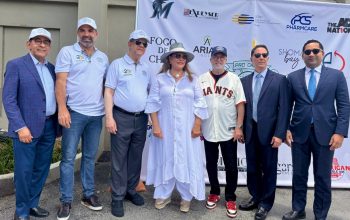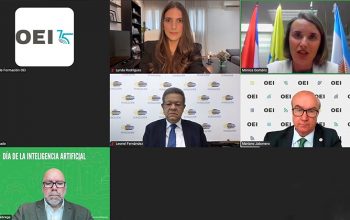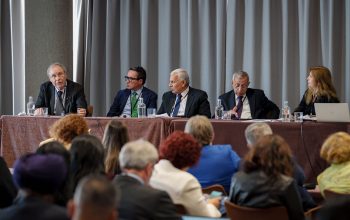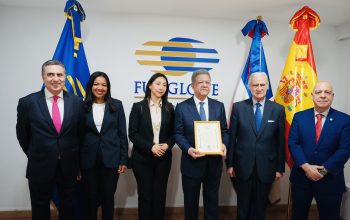news
GFDD and FUNGLODE Host Panel on DR-CAFTA in New York
September 25, 2007
Global Foundation for Democracy and Development (GFDD) and Fundación Global Democracia y Desarrollo (FUNGLODE) organized a panel on the US, Dominican Republic and Central American Free Trade Agreement (DR-CAFTA) on September 20, 2007 at the City University of New York (CUNY) as part of Dominican Week in the United States.
 Ellis Pérez, Dominican Week in the United States Committee Organizing Member, welcomed the audience and introduced panelists: Melanio Paredes, State Secretary of Industry and Trade; Eddy Martínez, Director of the Dominican Republic Center for Exports and Investments (CEI-RD); Esther Aristy, Head of FUNGLODE’s Free Trade Unit; and Andres Vanderhorst, Executive Director of the National Council on Competitiveness
Ellis Pérez, Dominican Week in the United States Committee Organizing Member, welcomed the audience and introduced panelists: Melanio Paredes, State Secretary of Industry and Trade; Eddy Martínez, Director of the Dominican Republic Center for Exports and Investments (CEI-RD); Esther Aristy, Head of FUNGLODE’s Free Trade Unit; and Andres Vanderhorst, Executive Director of the National Council on Competitiveness(CNC).
Melanio Paredes spoke of the apprehension concerning the agreement felt by members the business sector, as well as the economic benefits associated with the agreement. He argued that unlike products manufactured in Taiwan, Dominican manufactured products enter into the US market tariff-free.
Paredes referred to the opening of an office in Lower Manhattan devoted to
expanding US – Dominican trade relations, and described it as a milestone in Dominican history.
expanding US – Dominican trade relations, and described it as a milestone in Dominican history.
Eddy Martínez highlighted the economic gains experienced by the Dominican Republic as a result of DR-CAFTA, principally increased foreign investment, commercial reciprocity and tax deductions. He also emphasized the treaty’s role in increasing the Region’s visibility abroad.
“Now the Region is known worldwide as the DR-CAFTA Region, awarding us a stronger position,” declared Martínez. “Several companies from Europe, Asia and Canada have demonstrated interest in settling in the Dominican Republic and some have already done so. Some did it before the agreement and have created employment opportunities.” Increased interest in the Dominican Republic and Central
America is largely due to tariff reduction and greater flexibility with regard to the manufacturing process.
America is largely due to tariff reduction and greater flexibility with regard to the manufacturing process.
Martínez indicated that up until now, the outcomes of DR-CAFTA have been the opposite of what was initially anticipated, stating that the agricultural and agro-industrial sectors that had initially opposed the agreement have been able to substantially increase their exports, whereas, the sectors that initially supported the agreement, such as the
textile sector, have not reaped the benefits of the agreement to the same degree.
textile sector, have not reaped the benefits of the agreement to the same degree.
In terms of foreign investment, the CEI-RD Director declared that last year foreign direct investment reached record levels and that foreign investment for the coming year was anticipated to reach US $1,300.
Regarding exports, he ascertained that while national exports annually have
totaled approximately US $800 million during the last 25 years, future projections indicate that exports to duty-free zones will amount to US $2,000 million. According to Martínez, the implementation of DR-CAFTA has led the national per capita income to double over the last three years, in turn positively impacting the quality of life for Dominicans.
totaled approximately US $800 million during the last 25 years, future projections indicate that exports to duty-free zones will amount to US $2,000 million. According to Martínez, the implementation of DR-CAFTA has led the national per capita income to double over the last three years, in turn positively impacting the quality of life for Dominicans.
Martínez also highlighted the vast potential for heightened
trade between the Dominican Republic and New York. While trade relations between the Dominican Republic and other sections of the United States have increased, trade between the Dominican Republic and New York has declined. The CEI-RD Director posited that the opening of the office in Manhattan seeks to strengthen economic relations between the Dominican Republic and the US city. CEI-RD is currently working t
trade between the Dominican Republic and New York. While trade relations between the Dominican Republic and other sections of the United States have increased, trade between the Dominican Republic and New York has declined. The CEI-RD Director posited that the opening of the office in Manhattan seeks to strengthen economic relations between the Dominican Republic and the US city. CEI-RD is currently working t






